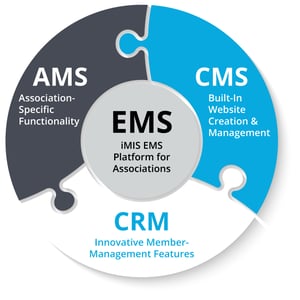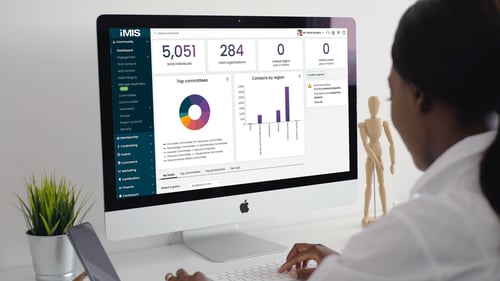When searching for a new Learning Management System (LMS), you can usually narrow down the list of contenders by asking which one integrates easily with your EMS, AMS, or CRM. That’s an important question but it’s only one of many LMS integration questions you should consider before making your selection decision.
You need to think through all the details of integration so you’re prepared for implementation. As John Leh, CEO and Lead Analyst at Talented Learning reminded us in his post:
“It’s critical to define…the functional what, when, how, and why for each integration. Otherwise, you’ll be forced to deal with these details in the heat of the implementation process. That’s a sure way to expand your project scope, cost, and time to completion.”
6 benefits of LMS integration
In case you’re getting push-back about integrating the new LMS with your other systems, let’s take a moment to review some of the benefits of LMS integration. First, let’s define what those systems may be:
• EMS stands for Engagement Management System, eg. iMIS.
• AMS is the acronym for Association Management System
• CRM is shorthand for a Customer Relationship Management system like Salesforce or Hubspot.
All three platforms are used by associations to manage data for their members and non-members who engage with their association, and each has different benefits and features.

1) Eliminate Double Data Entry and Manual Reporting
Because integration eliminates double data entry and manual reporting, staff no longer has to spend time on those arduous tasks and can focus their attention elsewhere.
2) Get a 360-View of Members
Get a 360-view of members and customers thanks to data from multiple systems, for example, your EMS/AMS, LMS, and online community. The LMS writes learner data and activities back to the EMS/AMS when a program or course is completed or when credits, credentials, or certificates are earned.
3) Build and Populate Groups
Build and populate groups in the LMS based on EMS or AMS data. For example, you can create a group for each chapter, and a group for chapter presidents.
4) Personalize the LMS User Experience
Members and nonmembers see relevant catalog offerings and pricing.
5) Integrations to Foster Engagement and Interaction
Enhance the learning experience with integrations to your online community for course discussions and networking, webinar/web conferencing platform for live webcasts, and digital badge platforms.

6) Single Sign-On (SSO)
Share user information and permissions with Single Sign-On so learners don’t have to re-enter login information.
LMS integration issues to consider before making a selection
If you’ve never done an integration before, you won’t know what to expect. Ask your vendors and/or network for an introduction to someone who’s recently handled integration during an LMS implementation project so you can get a better sense of what lies ahead.
Stakeholder Buy-In
Is everyone on board with integration? Make sure no department stands in the way of integrating the LMS with the EMS, AMS, or other systems. Ensure the buy-in of the IT, membership, marketing, professional development, and conferences and meetings teams by involving their subject matter experts in identifying functional and technical LMS requirements, including integration requirements.
Address their needs and concerns during requirements discussions. Enlist the support of the project’s executive sponsor if you run into any resistance. Ask the team representatives to sign off on the requirements and project scope documents.

System of record
Identify the system of record for each data set. For example, if your EMS or AMS controls your member/customer portal, you may want it to be the system of record for LMS users, groups, and events/products. On the other hand, the LMS could be the system of record for CE credits. Learners claim, record, and are awarded credits in the LMS, and then that data is written back to the EMS.
Data
Get a clear understanding of the data the LMS will need from the EMS/AMS and the data the LMS will write back to the AMS. Think about the member/customer profile data you need in the LMS, and the learning data you want in the member/customer’s EMS/AMS record. Only sync required data, you don’t want to overcomplicate things.
Identify any group hierarchy you want copied to the LMS, for example, chapters, students, and corporate licensees.
Find out what LMS data your colleagues need to answer questions, make decisions, help volunteer leaders make decisions, and achieve business and strategic goals. For example:
• The membership team may want LMS data for member engagement metrics.
• Marketing staff may need LMS data to measure the effectiveness of promotions.
• The conferences and meetings team may want LMS data to spot content trends and program gaps.
Reports
Determine which system (EMS or LMS) is better to use when creating reports. Check the level of detail available in that system’s reports to make sure you can provide the information needed by your team and your colleagues. Nail down your reporting requirements before you select an LMS.

Catalog and eCommerce
Where do you want members and customers to search for online learning programs and where do you want them to make their purchase (register/enroll)—in your LMS or EMS/AMS? Transactions and data can be processed and stored in either one, but you should choose one of them for hosting both your eLearning catalog and eCommerce. Separating these functions usually requires costly customization.
Single Sign-On (SSO)
Does your EMS or AMS have SSO functionality? SSO provides a better user experience since the AMS authenticates the user as a member or non-member and the appropriate pricing and viewing permissions can be applied to their experience.
9 LMS integration questions to ask vendors
If you’re not confident about the technical knowledge on your team, think seriously about working with an LMS consultant. They’ll help your team think through all integration and implementation issues, make the right decisions, and know what questions to ask.
 1) Have you integrated with our AMS/CRM before? Find out specifically which versions of your EMS/AMS/CRM their integration supports. Ask for references of clients who have an integration with the same version of the platform.
1) Have you integrated with our AMS/CRM before? Find out specifically which versions of your EMS/AMS/CRM their integration supports. Ask for references of clients who have an integration with the same version of the platform.
 2) What integration API capability does the AMS have? Ask for documentation and have someone with technical expertise review it.
2) What integration API capability does the AMS have? Ask for documentation and have someone with technical expertise review it.
 3) Is it a real-time, two-way integration? You don’t want a one-way integration. A strong two-way integration allows data to be shared and synced between the two systems, giving you more information and alleviating administrative tasks.
3) Is it a real-time, two-way integration? You don’t want a one-way integration. A strong two-way integration allows data to be shared and synced between the two systems, giving you more information and alleviating administrative tasks.

 4) Does the LMS integrate with our online community? You should be able to enhance the learner experience with online discussion forums—and track community participation.
4) Does the LMS integrate with our online community? You should be able to enhance the learner experience with online discussion forums—and track community participation.
 5) What webinar/web conferencing platforms do you integrate with? Make sure it’s an end-to-end integration. For example, if the webinar event is created in the AMS, it should automatically be created in the LMS. When it’s launched and completed from the LMS, the attendance info should be written back to the EMS or AMS.
5) What webinar/web conferencing platforms do you integrate with? Make sure it’s an end-to-end integration. For example, if the webinar event is created in the AMS, it should automatically be created in the LMS. When it’s launched and completed from the LMS, the attendance info should be written back to the EMS or AMS.

 6) Who’s doing the integration? TopClass LMS clients have a single point of support because all integration work is done in-house, but that’s not always the case with other vendors. Many of them use third-party developers to handle integration.
6) Who’s doing the integration? TopClass LMS clients have a single point of support because all integration work is done in-house, but that’s not always the case with other vendors. Many of them use third-party developers to handle integration.
 7) What kind of setup do you require us to do? Make sure your project team has the technical expertise needed for any integration setup.
7) What kind of setup do you require us to do? Make sure your project team has the technical expertise needed for any integration setup.
 8) Is a test environment or sandbox available? Work out any unexpected issues in a safe, separate environment before you go live with the integration.
8) Is a test environment or sandbox available? Work out any unexpected issues in a safe, separate environment before you go live with the integration.

 9) Is the integration supported “out of the box?” The integration points in each system must be part of the core application of that system. If integration requires any customization of the core application, you could get thrown off the upgrade path.
9) Is the integration supported “out of the box?” The integration points in each system must be part of the core application of that system. If integration requires any customization of the core application, you could get thrown off the upgrade path.
Nowadays, integration is expected, but whether or not it’s easy depends on the LMS you choose. You can help ensure project success by taking time to consider these integration issues and asking your LMS vendor to shortlist these integration questions before you make your final LMS decision.
Reprinted with permission from the TopClass LMS blog.